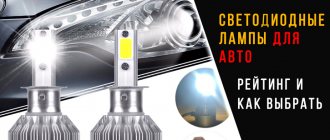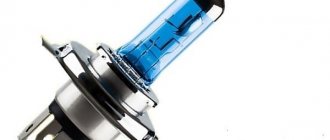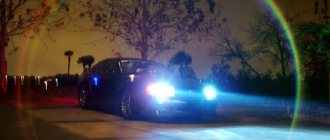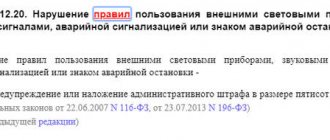Types of lamps
Before we talk about penalties for LEDs in car headlights, it is necessary to understand the difference between their different types. The following light sources are used in cars today:
- Incandescent lamps. In them, light is emitted by a spiral that heats up when an electric current passes through it. Air is evacuated from lamp bulbs to extend the life of the filament. Such lamps are the most affordable, but have a short resource and burn out quickly.
- Halogen. Incandescent lamps with the bulb filled with a buffer gas (a mixture of bromine and iodine halogens), which protects the coil from burnout. They are currently the most common source of headlights for cars.
- Xenon. Gas-discharge lamps filled with mercury and xenon vapor, in which a luminous electric arc is formed. Xenon sources produce a more bluish and brighter glow, have a high-quality reflector and good focusing.
- LED. Lamps in which radiation is emitted by a semiconductor when an electric current passes through it. They produce a stream of white radiation with a power of up to 6000 Kelvin. Today these are the brightest, most powerful and durable light sources.
Depending on the specific type of light source, headlights also differ. Thus, optics for halogen lamps are not suitable for LEDs, since they require a special lens to ensure correct focusing. If you install an LED in a headlight for halogen lamps, its glow will be too bright, with virtually no dispersion - it will hit the eyes of drivers of oncoming cars, which can ultimately lead to an accident. To make it easier to select lamps for headlights, the latter have special markings:
- C, K and CR - for incandescent lamps;
- HC, HR and HCR – for halogen;
- DR, DC and VSK - for xenon.
These types of headlights are officially permitted and reflected in regulations. There is no special marking for LED automotive optics in Russian legislation, since it is currently installed only on new imported vehicles. However, the LED lamps themselves are marked L, so it is expected that in the future this will also be used to designate headlights adapted for them.
Technical requirements for automotive light sources are reflected in the “Technical Regulations of the Customs Union”, as well as GOST 8769-75, GOST R 51709-2001 and “List of faults and conditions under which the operation of a vehicle is prohibited”. It is these documents that must be used as a guide when choosing and installing certain lamps on a vehicle.
It's all about the light bulb
Drivers' latest craze for LED bulbs may lead to unpleasant consequences for them.
Everyone is already accustomed to the fact that for installing the so-called “collective farm” xenon, you can lose your rights. It is to combat such headlights that Part 3 of Article 12.5 appeared in the Code of Administrative Offenses. It provides for a fine of five thousand rubles or deprivation of rights for lighting devices whose operating mode does not comply with the basic provisions for approval.
Indeed, the operating mode of xenon differs from conventional halogen lamps. Therefore, such headlights require special lenses, as well as automatic light adjustment.
The situation is different with LED lamps. They do not require additional electronic components. They don't need additional lenses. They do not require electronic tilt adjustment. But they do not meet safety requirements.
Recently, manufacturers of such lamps have achieved some success. To the point that the LEDs are now positioned exactly the same way the light from a halogen lamp should be directed. However, so far no LED manufacturer has been able to ensure that the light adjustment of such a headlight meets the requirements. Simply put, if you insert an LED headlight into a regular headlight designed for halogen lamps, then you will not pass the technical inspection. The headlight simply won't shine as well as it should.
The installation of such a lamp will be considered a modification to the design of the vehicle. But you won’t be able to get permission to make such a change, for the reason that the light is not adjusted as it should.
If you insert an LED headlight into a headlight designed for halogen lamps, you will not pass inspection.
Yes, there are cars that are originally equipped with LED headlights. For example, thrifty Chinese prefer to install just these on expensive models. This is generally the tendency of those who produce very expensive cars. But the optics on these cars are adapted specifically for such lamps.
Installing LED lamps in conventional halogen headlights threatens that the driver will be charged under Part 3 of Article 12.5 of the Administrative Code with deprivation of rights and confiscation of these very lamps.
competently
Sergey Smirnov, editor of Za Rulem magazine, lawyer:
— If a driver has installed LED lamps on a car that were not provided by the manufacturer, the punishment can be very severe.
At first glance, such an offense falls under the first part of Article 12.5, where the punishment is very harmless. Warning or fine 500 rubles.
On the one hand, this part applies to all malfunctions and conditions under which operation is prohibited. Including installing the wrong light. However, in Part 3 of Article 12.5 of the Code of Administrative Offenses of the Russian Federation, the legislator separately highlighted cases related to the installation of lighting devices that do not meet the requirements of the Basic Provisions for the admission of vehicles to operation.
Thus, paragraph 11 of the Basic Provisions prohibits the operation of vehicles if their technical condition and equipment do not meet the requirements of the same list of faults and conditions under which operation is prohibited.
And section 3 of this list lists all the cases associated with the use of the “wrong light”.
So, the punishment for using “illegal” LED lamps is no longer so harmless. The driver may well lose his license for a period of six months to a year.
When is it legal to use LED lamps?
There are several situations in which the use of LED lamps is not illegal:
- the vehicle is initially produced by the manufacturer with LED headlights - this applies to some foreign cars of the latest generation (Audi, Lexus, Ford, etc.);
- this car model and the corresponding headlights are no longer produced - that is, it is not possible to replace the optics;
- In this vehicle model, the manufacturer has provided the opportunity to replace the installed headlights with LED ones (in this case, the manufacturer itself installs LED optics on cars of this series, but released later).
In other cases, the unauthorized replacement by the owner of the car of “original” lamps with LED lamps is considered contrary to the law and is subject to administrative penalties.
Are you deprived of your license for LED lamps in headlights?
Today there are several options in which it is possible to use LED equipment in a car:
- During the production of the car, LED headlights were installed at the factory. This is completely legal, and the driver does not face any fine. Traffic police inspectors have this information and do not create problems for the driver;
- If the manufacturer installs such equipment on vehicles of the specified brand, then they can be installed on vehicles of this model that were previously produced by the plant without LED headlights. That is, if you install such lighting yourself, this will not constitute a violation;
- if the manufacturer did not provide for the installation of LED lighting, then this can be done if certain requirements are met.
What is the penalty for using LED lamps?
The liability of the car owner for the unauthorized installation of LED lamps is regulated by clause 3 of Art. 12.5 Code of Administrative Offences. In accordance with it, the following types of punishment are provided:
- Fine in the amount of 500 rubles;
- Deprivation of the right to drive a vehicle for a period of 6-12 months;
- Confiscation of LED lamps.
Practice shows that until mid-2021, the main punishment for this offense was deprivation of a driver’s license. However, from June 25, 2021, the resolution of the Plenum of the Supreme Court of the Russian Federation No. 20 changed the procedure for imposing sanctions, and now mainly a fine is issued for the installation of LED lamps. This is due to the fact that the requirements state that the basis for deprivation of a driver’s license is violation of the specified color of lights and operating mode. At the same time, most LEDs emit in the same spectrum as halogens - the difference can only be determined with the help of special equipment, which is not available at every traffic police station. In addition, deprivation of rights for LED lamps is carried out only through the court - this complicates the procedure and often traffic police inspectors prefer not to complicate their lives, limiting themselves only to a fine.
Legalization of LED lamps for cars
You can avoid being fined for LED headlights and use them freely by taking the following measures:
- purchase certified optics provided by the car model and allowing the installation of LED lamps;
- install optics with LED lamps in the car;
- write an application to the State Traffic Safety Inspectorate at the place where the vehicle is registered to change the design of the vehicle;
- undergo a vehicle inspection with the appropriate note in its diagnostic card;
- obtain a certificate of vehicle compliance with road traffic regulations.
If the automaker currently produces cars of your model with pre-installed LED optics, then you can also install LED lamps on your vehicle. Such changes will be considered to comply with the characteristics stated in the technical documentation and no punishment will follow.
Penalty for installing LED lamps
The fine for diode bulbs in headlights that do not correspond to the factory optics is 500 rubles. The same consequence will occur in any other case of discrepancy between the technical parameters of the standard optics (for example, when replacing halogen lamps with xenon ones or installing xenon optics with LED ones). LED low beam bulbs are fined only if they do not comply with the operational documentation provided by the vehicle manufacturer or have not received confirmation of compliance as part of the vehicle.
When can your rights be revoked?
Deprivation of rights for LED lamps is possible only if independent replacement in any way affects the functioning of optical partings - changes the quantity, color according to GOST, or operating mode. All this meets the requirements of Article 12.5 of the Administrative Code. But in practice, the issue of checking and recording violations is controversial, because the procedure requires appropriate equipment, which not all traffic police posts have.
Is it allowed to install LEDs in headlights?
You can read about the possibility of replacing lamps in headlights in paragraph 3.4 of the List of malfunctions and conditions prohibiting the operation of the vehicle. It states that a malfunction is considered to be a mismatch between the types of lenses and the lamps themselves. In simple terms, the lamps installed must correspond to the markings indicated on the headlights.
Markings suitable for LED lamps
The classification and marking of headlights is given in the Technical Regulations of the Customs Union. To decipher the markings, you will need to know the symbols: R – low beam, C – high beam, CR – lamp with the ability to switch the beam range. If the lenses are suitable only for halogen headlights, then the letter H is placed in front of the corresponding letters. Xenon lamps can be installed in lenses whose markings begin with the letter D, and the symbols B or F3 indicate fog lamps.
As can be seen from the classification, the Technical Regulations do not provide for markings for LED lamps. But they can still be installed on cars. Moreover, on some car models, LED lamps are standard, and the headlights are marked with halogen lenses. That is why forensic experts allow the installation of LED lamps only in halogen lenses: HR - low beam, HC - high beam, HCR - one lamp with a two-mode operation option.
Additional requirements for installing LEDs
For LED lamps, as for xenon lamps, there are additional requirements in addition to compliance with the labeling. The car must have automatic headlight levelers and headlight washers. Without them, the use of LED lamps is also prohibited
What exactly do we mean by LED headlights?
In this article we will talk about the types of LED lamps (note: the abbreviation LED stands for “Light Emitting Diode”) that are placed in the housing of car headlights, the latter of which were originally designed to work with halogen incandescent lamps. Typically, such an installation is simply called “LED lamps.”
Of course, we will not consider here cars that are equipped with LEDs from the factory, or so-called high-intensity discharge (HID) lamps and other offshoots. LEDs only.










